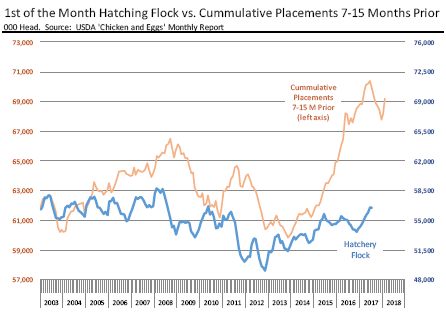



CME: US Broiler Production Forecast Adjusted Down to 0.3%
US - US consumers will have plenty of meat protein options this fall. So far demand has been quite robust, evidenced by the higher year/year prices for many products despite increased availability, reports Steiner Consulting Group, DLR Division, Inc.In our daily reports we often focus on red meat supply trends and it is easy to forget that out of the +100 billion pounds of meat protein that will be produced this year, over 40 per cent of that will be chicken. Growth trends in chicken production this year have been a bit slower than earlier expected.
At the start of the year USDA had pegged US broiler production in 2017 to be 41.13 billion pounds, 2.2 per cent higher than last year. That forecast has been adjusted down to 41.04 billion, or 0.3 per cent less than earlier expected.
Have broiler producers managed to find some much needed discipline in managing production growth? Maybe although we suspect that other factors may be at play.
Consider that weekly egg sets this year have averaged 2.5 per cent above year ago levels and yet chick placements are up only 1.5 per cent (this data is updated weekly in our Monday report). There appears to be some consensus among poultry analysts that the decline in productivity may be tied to the expansion of NAE production (no antibiotics ever).
The decline in productivity may explain some of the slower growth we have experienced this year. The number of eggs produced for broiler production is a function of the hatching flock and the size of the hatching flock itself has under-performed, at least when we compare it with the pullet placements in previous periods.
Often we see reports from poultry analysts and USDA that reference pullet placements as an indicator of industry expansion/contraction. That may very well be the case but when we consider the hatching flock relative to those pullet placements something appears to be amiss.
In the last three years, the cumulative number of placements has increased substantially and yet we have seen only modest increases in the size of the broiler hatching flock. Only in the last three months have we seen the broiler hatching flock start to increase compared to a year ago. We suspect this may have to do with the notable improvement in profitability in the recent quarters.


Whole bird prices are up 18 per cent compared to last year but that only gives you the value of small birds sold at retail. The bulk of the chicken produced in this country is sold as parts, going to retail or foodservice establishments.
There is no reported cutout value for broilers but one can calculate an approximation using the value of leg quarters, wings and line run breasts. According to our calculation, the implied broiler cutout value is currently $26/cwt or +41 per cent higher than a year ago.
What is driving the gains in chicken prices? Wing prices are at all-time record highs and they have contributed to the gains but they are not the driver for profitability. According to USDA, the price of line run chicken breasts last week was $119/cwt, a 45 per cent gain over the dismal levels of a year ago.
Boneless/skinless breast prices were running at +30 to 35 per cent over last year through July but have come back to earth recently so line run breasts could follow the same path. However, the improved profitability in the short term could encourage broiler producers to look for ways to bolster supply.
After all, there are profits to be had and whoever can respond the quickest wins. One way to quickly get some additional supply is to bring to market heavier birds and slaughter of very large boning birds has averaged +15 per cent over last year since June.

The question is - will we see a much larger hatching flock in Aug/Sep and thus larger than expected broiler slaughter in Q4 and early next year?








